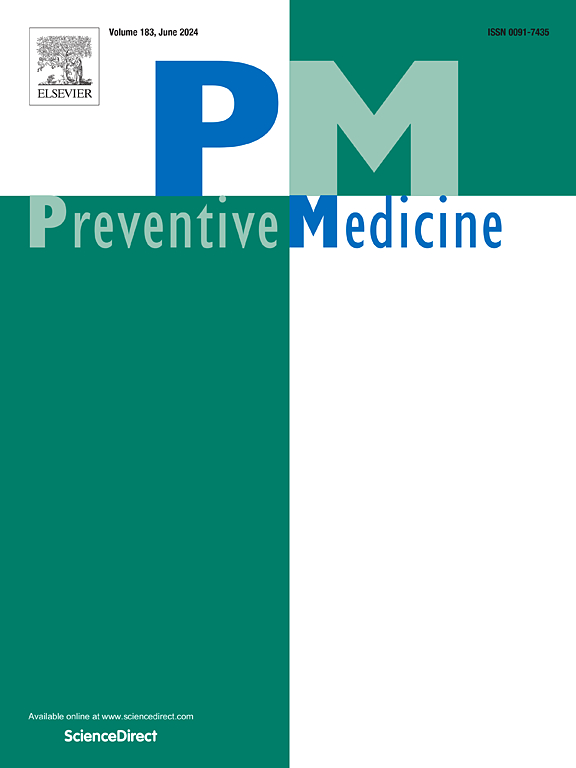Association between an active lifestyle and reduced incidence of obesity-related cancers in the Seguimiento Universidad de Navarra cohort
IF 3.2
2区 医学
Q1 MEDICINE, GENERAL & INTERNAL
引用次数: 0
Abstract
Objective
To assess whether physical activity, sedentary behavior, and an active lifestyle score, combining physical activity and sedentary behavior, are associated with developing obesity-related cancers (ORCs).
Methods
From 1999 through 2022, a cohort of Spanish university graduates was followed using biennial questionnaires collecting data on sociodemographic characteristics, clinical diagnoses, and lifestyle factors. We used a previously validated questionnaire to assess physical and sedentary activities (television watching+sitting time), from which we estimated an eight-item active lifestyle score. Cancer incidence was confirmed with medical records and the National Death Index. Multivariable-adjusted hazard ratios (HRs) were estimated with Cox regression models.
Results
Higher adherence to the active lifestyle score nearly halved the risk of ORCs (HR high vs. low 0.45 (95 %CI 0.27–0.73)). The HR in quartile four (Q4) of leisure-time physical activity was 0.54 (95 %CI 0.37–0.80) compared to Q1. The HR per +1-point increase in the score was 0.88 (95 %CI 0.81–0.95). No significant association was observed between television watching and ORCs risk.
Conclusions
A higher active lifestyle score was associated with a decreased risk of ORCs. These findings may aid public health organizations in refining recommendations in ORC prevention to include interventions focused on combining increased physical activity and lowered sedentary behavior.
Seguimiento university de Navarra队列中积极的生活方式与减少肥胖相关癌症发病率之间的关系
目的:评估身体活动、久坐行为和积极生活方式评分(结合身体活动和久坐行为)是否与肥胖相关癌症(ORCs)的发生有关。方法:从1999年到2022年,对一组西班牙大学毕业生进行了两年一次的问卷调查,收集了社会人口统计学特征、临床诊断和生活方式因素的数据。我们使用先前验证过的问卷来评估身体和久坐不动的活动(看电视+坐着的时间),从中我们估计了8项积极生活方式的得分。癌症发病率通过医疗记录和国家死亡指数得到确认。采用Cox回归模型估计多变量校正风险比(hr)。结果:坚持积极生活方式得分越高,发生ORCs的风险几乎减半(HR高比低0.45(95 %CI 0.27-0.73))。与Q1相比,第四分位数(Q4)的休闲时间身体活动的HR为0.54(95 %CI 0.37-0.80)。每增加1分,HR为0.88(95 %CI 0.81-0.95)。没有观察到电视观看与ORCs风险之间的显著关联。结论:积极生活方式评分的增加与ORCs风险的降低相关。这些发现可能有助于公共卫生组织完善ORC预防建议,包括集中于增加体育活动和减少久坐行为的干预措施。
本文章由计算机程序翻译,如有差异,请以英文原文为准。
求助全文
约1分钟内获得全文
求助全文
来源期刊

Preventive medicine
医学-公共卫生、环境卫生与职业卫生
CiteScore
7.70
自引率
3.90%
发文量
0
审稿时长
42 days
期刊介绍:
Founded in 1972 by Ernst Wynder, Preventive Medicine is an international scholarly journal that provides prompt publication of original articles on the science and practice of disease prevention, health promotion, and public health policymaking. Preventive Medicine aims to reward innovation. It will favor insightful observational studies, thoughtful explorations of health data, unsuspected new angles for existing hypotheses, robust randomized controlled trials, and impartial systematic reviews. Preventive Medicine''s ultimate goal is to publish research that will have an impact on the work of practitioners of disease prevention and health promotion, as well as of related disciplines.
 求助内容:
求助内容: 应助结果提醒方式:
应助结果提醒方式:


